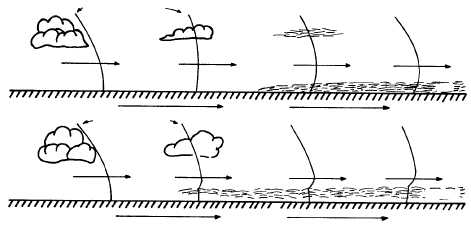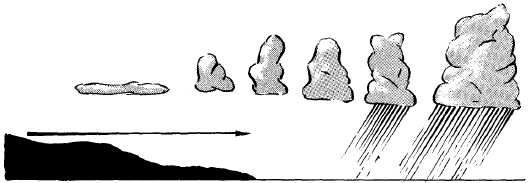AIR MASS MODIFICATION
When an air mass moves out of its source region, a
number of factors act upon the air mass to change its
properties. These modifying influences do not occur
separately. For instance, in the passage of cold air over
warmer water surfaces, there is not only a release of
heat to the air, but also a release of some moisture.
As an air mass expands and slowly moves out of its
source region, it travels along a certain path. As an air
mass leaves its source region, the first modifying factor
is the type and condition of the surface over which the
air travels. Here, the factors of surface temperature,
moisture, and topography must be considered. The type
of trajectory, whether cyclonic or anticyclonic, also has
a bearing on its modification. The time interval since
the air mass has been out of its source region
determines to a great extent the characteristics of the air
mass. You must be aware of the five modifying factors
and the changes that take place once an air mass leaves
its source region in order to integrate these changes into
your analyses and briefings.
Surface Temperature
The difference in temperature between the surface
and the air mass modifies not only the air temperature,
but also the stability of the air mass. For example, if the
air mass is warm and moves over a colder surface (such
as tropical air moving over colder water), the cold
surface cools the lower layers of the air mass and the
stability of the air mass increases. This stability extends
to the upper layers in time, and condensation in the
form of fog or low stratus normally occurs. (See fig.
4-2.)
If the air mass moves over a surface that is warmer
(such as continental polar air moving out from the
continent in winter over warmer water), the warm water
heats the lower layers of the air mass, increasing
instability (decreasing in stability), and consequently
spreading to higher layers. Figure 4-3 shows the
movement of cP air over a warmer water surface in
winter.
The changes in stability of the air mass give
valuable indications of the cloud types that will form, as
4-5
AIR TEMPERATURES
AIR TEMPERATURES
LIGHT WINDS
MOD. WINDS
STRATUS
WARM
WARM
COLD
COLD
BECOMING
OVER LAND OR WATER
BECOMING
OVER LAND OR WATER
FOG
AG5f0402
Figure 4-2.—Passage of warm air over colder surfaces.
COOL CONTINENT
WARM OCEAN
AG5f0403
Figure 4-3.—Continental polar air moving from cool continent to warm ocean (winter).




